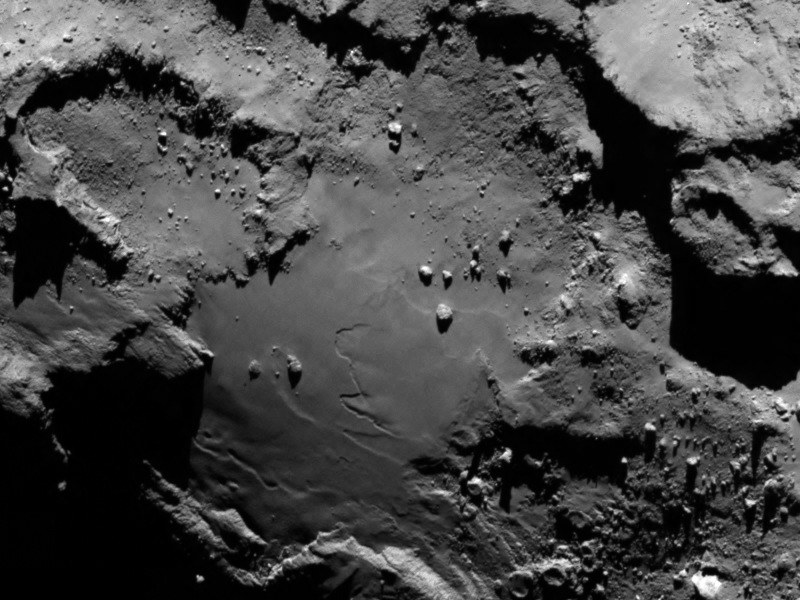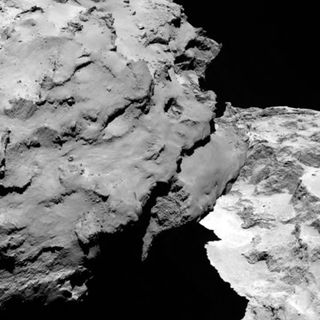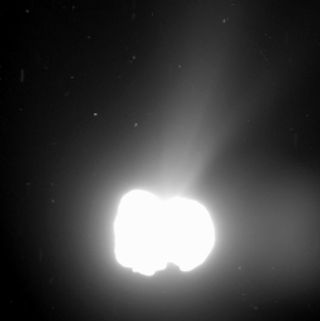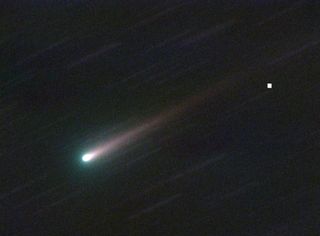First Comet Close-Ups from Rosetta Spacecraft Reveal a 'Scientific Disneyland' (Photos)

It's only been a few hours since Europe's Rosetta spacecraft arrived at a comet in deep space, but the robotic probe is already beaming incredible close-up photos of its target.
The latest images from the Rosetta probe reveal details on the surface of Comet 67P/Churyumov-Gerasimenko like never before. House-size boulders can be seen on the surface of the comet, and the "neck," "body" and "head of the dirty snowball are all on stark display. The photos were taken when Rosetta was about 81 miles (130 kilometers) away from the comet.
"We've arrived. Ten years we've been in the car waiting to get to scientific Disneyland, and we haven't even gotten out of the car yet and look at what's outside the window," Mark McCaughrean, senior scientific adviser with the ESA's Directorate of Science and Robotic Exploration, said during a webcast of the Rosetta's comet arrival today (Aug. 6). "It's just astonishing." [Europe's Rosetta Probe's Historic Comet Arrival (Video)]

And McCaughrean wasn't alone in his enthusiasm at Rosetta's mission operations center in Darmstadt, Germany.
"This is a very, very emotional moment," Holger Sierks, the principal investigator for Rosetta's OSIRIS instrument, said during the webcast. "You see a lot of detail coming out here. We see the bright areas. We see the head. We see the depression and a lot of stuff laid out there. We see the sides, the body, the lower body of the nucleus and a lot of detail."
Both Rosetta and Comet 67P/C-G are flying in tandem at about 251 million miles (405 million km) from Earth. Rosetta set off on its quest to link up with the comet in 2004, traveling about 4 billion miles (6.4 billion km) before making its historic rendezvous with the comet this morning.While today does mark an event 10 years in the making, it is just the beginning of the mission for many ESA scientists.
ESA officials still need to find a suitable landing spot for the Philae lander, a robotic craft that hitched a ride with Rosetta to the comet. Philae (named for an obelisk found on an island in the Nile River) is designed to touch down on the surface of Comet 67P/G-C to learn more about the composition and properties of the 2.5-mile-wide (4 km) comet.
Get the Space.com Newsletter
Breaking space news, the latest updates on rocket launches, skywatching events and more!

Mission controllers will now put Rosetta into a triangular orbit around Comet 67P/Churyumov-Gerasimenko (67P/C-G) before moving the probe closer to the comet. Eventually, Rosetta will move into an even tighter circular orbit to release its lander down to the comet's surface in November.
The $1.7 billion (1.3 billion euros) Rosetta mission is expected to end in December 2015 when the spacecraft moves away from Comet 67P/C-G. Before the end of the mission, however, Rosetta will accompany the comet as it makes its closest pass of the sun in its 6.5-year orbit. During that close pass, the probe should be able to observe the comet in a very active state.
"After landing, Rosetta will continue to accompany the comet until its closest approach to the sun in August 2015 and beyond, watching its behavior from close quarters to give us a unique insight and real-time experience of how a comet works as it hurtles around the sun," Matt Taylor, Rosetta project scientist, said in a statement.
Follow Miriam Kramer @mirikramer and Google+. Follow us @Spacedotcom, Facebook and Google+. Original article on Space.com.

Join our Space Forums to keep talking space on the latest missions, night sky and more! And if you have a news tip, correction or comment, let us know at: community@space.com.

Miriam Kramer joined Space.com as a Staff Writer in December 2012. Since then, she has floated in weightlessness on a zero-gravity flight, felt the pull of 4-Gs in a trainer aircraft and watched rockets soar into space from Florida and Virginia. She also served as Space.com's lead space entertainment reporter, and enjoys all aspects of space news, astronomy and commercial spaceflight. Miriam has also presented space stories during live interviews with Fox News and other TV and radio outlets. She originally hails from Knoxville, Tennessee where she and her family would take trips to dark spots on the outskirts of town to watch meteor showers every year. She loves to travel and one day hopes to see the northern lights in person. Miriam is currently a space reporter with Axios, writing the Axios Space newsletter. You can follow Miriam on Twitter.